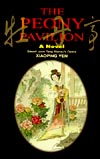Looking for a Peony Pavilion That's Easy to Read?
By ALEXA OLESEN
 (Virtual China News, Feb. 28) The Peony Pavilion, a 22-hour Ming Dynasty opera, is often compared to works by Shakespeare -- not because Peony actually reads like Hamlet but because Shakespeare and the author of Peony, Tang Xianzu both happened to die in 1616.
(Virtual China News, Feb. 28) The Peony Pavilion, a 22-hour Ming Dynasty opera, is often compared to works by Shakespeare -- not because Peony actually reads like Hamlet but because Shakespeare and the author of Peony, Tang Xianzu both happened to die in 1616.
This morbid parallel between two playwrights who lived worlds apart is a remarkably handy touchstone for westerners interested in traditional Chinese culture. That Shakespeare and Tang Xianzu both died in 1616 is a piece of trivia, but one that makes the hopelessly exotic seem instantly familiar. Miguel de Cervantes also died in 1616. In Spain, Tang Xianzu is probably known as the Chinese playwright who died the same year as the author of Don Quixote.
Cross-cultural appreciation of classical literature is not easy. Most native English speakers find it hard enough to enjoy Hamlet, much less a 400-year-old Chinese opera with as many pages of footnotes as actual text. For most of us, reading classical Chinese literature in translation is a lot like eating bonefish -- it's tasty enough but probably not worth the effort.
Fans of fish sticks will be happy to know there is now an easily-digestable version of The Peony Pavilion.
Last year a new English-language version of Tang Xianzu's Peony Pavilion was released by Homa and Sekey, a publishing company in New Jersey. This new version, which reads like a supermarket bodice ripper, was written by Yen Xiaoping, a literature professor at the City University of New York. It is one of the most charming and accessible versions of the Ming Dynasty classic available. And it's illustrated.
Yen's version (an adaptation, not a translation) of The Peony Pavilion, is a bawdy, plot-driven lark, a simple and charming distillation of a great piece of Chinese literature. The book was written last year to be sold at the Lincoln Center production of The Peony Pavilion, a well-publicized 22-hour performance of the entire opera. Viewers paid US$210 for the show, which was broken into three-hour installments.
Even though it was subtitled, many Lincoln Center laygoers walked away confused. The English translation was incomplete and hard to follow. As a result, Yen's "novelized" paperback version sold like hotcakes. He and the book's editor, Shawn Ye, sold the books personally at a table set up in the Lincoln Center lobby throughout the production.
Either as accompaniment to the stage production or read by itself, Yen's novel of The Peony Pavilion is a wonderful way to acquaint oneself with this masterpiece. While Yen's Peony fails to capture the beauty of the original language, it is an excellent synopsis of the Opera's plot and it gives a very clear sense of the main players' characters.
The Peony Pavilion is a tale of an idealized vision of love that drives an aristocratic young maiden, Du Liliang, to die of heartache. After three years in a Taoist purgatory, the winsome beauty is given another chance at life by a softhearted immortal bureaucrat. He allows her one more year of life and one more chance to seduce and marry the man of her dreams. Set against the backdrop of Song Dynasty politics and the Han Chinese government's struggle to beat off the invading Tartar barbarians, the story is rife with plot twists and odd characters.
The hundreds of players in the original piece are pared down in Yen's version to an easy-to-follow handful, but the novel is enriched with cameos by lascivious nuns, corrupt officials, scurrilous grave robbers and a pair of prostitutes called Rose and Spring Leaf.
The plot, which is considerably abbreviated, gives a good overview of the Opera's main events and deftly weaves simple explanatory background into the text, such as a brief history of bound feet and an explanation of the Chinese imperial exam system. Targeted to the Westerner with little or no background in Chinese history and culture, the novel sets out to make the Peony accessible, and succeeds.
"We used simple language for general readers," says the publisher and editor, Shawn Ye. "We created it for general readers in the West and for third- or fourth-generation American Chinese readers who want to know something about their culture. This book is not for academics."
To be sure, Yen's novel is far from a direct translation and the English used falls well short of poetry. Compare this excerpt from a faithful translation of The Peony Pavilion:
"Slippery mud,
sloppery thud,
short rake, long plough, clutch 'em as they slide.
After rainy night sow rice and hemp,
when sky clears fetch out the muck,
then a stink like long-pickled fish
floats on the breeze."
To a similar type of description in Yen's version:
"Sometimes bats flew into the open rafters and took a break. Other times, mice scampered by quickly in their search for food. In the pond, frogs crackled for mates. In the grass, light bugs congregated. It was lonely to spend the nights with only the animals."
Occasionally in the novel mistranslations detract from the authors credibility. Here "canal" is unfortunately yet amusingly confused with "carnal":
"It seems your pious search took you last night into the room occupied by Scholar Liu. Did you find ... canal satisfaction?"
Goofy little (unintentional?) mistakes of this sort add to the light-hearted tone of this Peony, as long as it's approached not as a faithful rendition but as an easy way to access an otherwise very unfamiliar classic.
Like movie adaptations of Shakespeare that are done in contemporary language, much is lost in the translation but it makes picking up the original a possibilty and an even greater pleasure.
To reach Alexa Olesen: alexa@virtualchina.net

